Coal delivered to houses, early 20th century
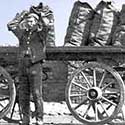
In the early years of the 20th century, coal was delivered in sacks by horse and cart. This page describes the type of cart which eased the delivery and how the horses were kept calm throughout the process. Photos of the carts show the price of the coal which illustrates the extent of inflation.
____
Extracted from the memoirs of the webmaster's mother (1906-2002) and edited by the webmaster with further research and firsthand contributions from others
When I was a child on a typical housing estate in the early 1900s, coal fires were our only means of heating rooms, heating hot water and cooking. So coal was an essential item and deliveries could frequently be seen on the streets.
The coalman's delivery cart
The coal was delivered by a coalman from a horse and cart.
The cart special for its purpose. As shown in the following image, it was a flat platform to allow coalmen to drag rather than lift the heavy bags onto their backs, but there were removable ropes round it to keep the sacks of coal in place while the cart was moving.
The sacks were packed in cwts (hundredweights) where one cwt is just over 50 kg - very heavy to carry! As as example of inflation, the sign at the side reads 1/- per cwt. One shilling is equivalent to 5p in today's money.
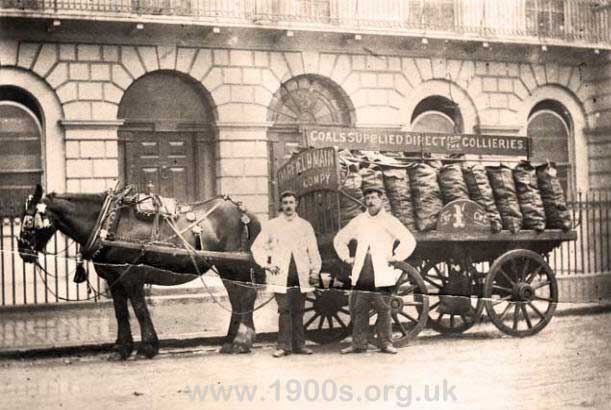
An early 1900s horse-drawn coal delivery cart showing its open sides loaded with sacks of coal. The photo is courtesy of Gillian Smyth and shows James Smyth with one of his brothers.
The placard at the top of the cart reads: COALS SUPPLIED DIRECT FROM THE COLLIERIES; the one at the front reads DARFIELD MAIN COAL COMPANY;
The page on the coalmen's appearance explains the white coats which might at first seem surprising for anyone working with coal. So the two brothers in the photo either worked in the coal office or drove the delivery cart. The actual delivery men, the coalmen, were not in the photo.
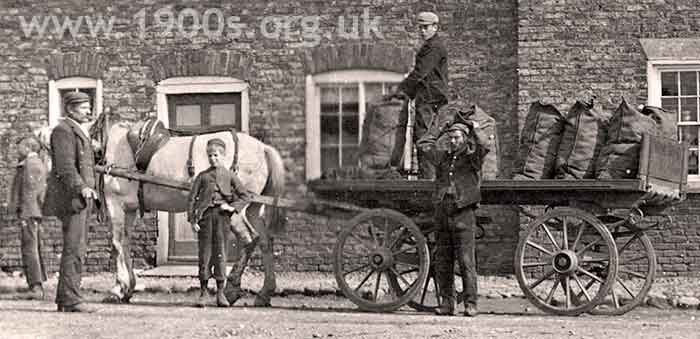
This early 1900s photo of a similar open-sided coal delivery cart is courtesy of Moyra Hill.
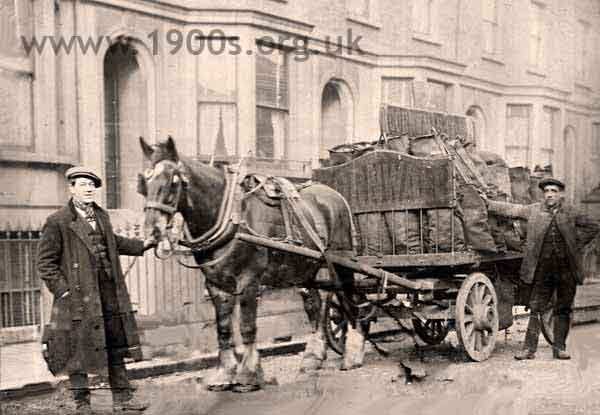
Another photo showing the open-sided coal delivery cart. Photo courtesy of Bob Warr.
How horses were kept calm and comfortable on deliveries
All large deliveries in Victorian times were by horse and cart and this continued to a decreasing extent until the mid-20th century. So it is worth explaining how the horses were kept calm and comfortable as they moved through traffic - granted that traffic was much less than it is today.
Horses' blinkers
Blinkers were always worn by workhorses on the streets. They blocked anything but straight ahead from the horses' vision, which kept them calmer and more controllable. You will see them on all the horses on the numerous delivery photos on this website.
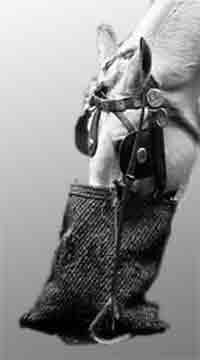
Horse wearing blinkers so as not to distract him from anything happening other than straight ahead.
He is also wearing a nosebag - see next section.
The horses were steered with a slight pull on the bit in a horse's mouth, although they usually got to know a delivery route as and the way back to base without any action from the driver.
Horses' nosebags
Nose bags (also written as nosebags) were filled with food and wore round the horses necks so that they could eat as and when they felt like it. I saw this regularly on the streets in the 1940s.
Horse droppings
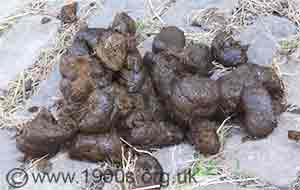
The horses defacated whenever and wherever they felt like it, to the delight of gardeners who prized the free manure. I saw this on the streets as late as the 1950s.
Tipping the coalman
As the coalman left, my mother would always tip him two pennies which was a lot of money in those days. It was expected, and was presumably so that he would remember to be careful not to touch the walls or knock anything over next time. Remember how dirty he was and that he was carrying heavy and equally dirty bags. Afterwards he would respectfully touch his hat in acknowledgement of the tip.
The delivery
The actual delivery is described from the householder's point of view on another page.
By the time of the 1920s and 30s housing estates, the coal was delivered to coal bunkers outside at the back of the house.
Comment by David Perfect, from personal recollections
My mother, who never trusted the coalmen, always had my sister and me stand outside to count the sacks as they were delivered.
| sources | webmaster | contact |
Text and images are copyright
If you can add anything to this page or provide a photo, please contact me.



